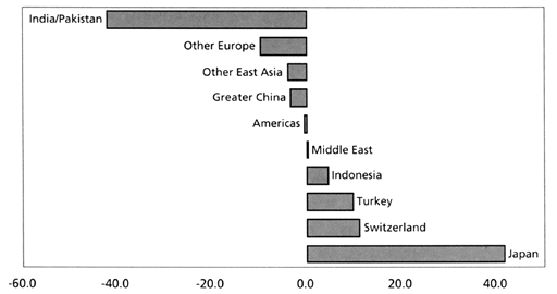Faced with a stronger U.S. dollar price and an uncertain economic outlook, global demand for gold fell 14.3% to 729 tonnes during the second quarter, according to Gold Demand Trends, published by the London-based World Gold Council (WGC).
On the consumer side, global jewelry demand was off 15.8% at 580.8 tonnes and retail investment fell 11.7% to 56.8 tonnes. The study suggests increased investment in some countries was outpaced by dis-hoarding at higher prices in other countries.
In the industrial sector, demand slipped 6.4% to 74.4 tonnes, while dental demand provided the lone bright spot, edging up 0.4% to 17 tonnes. Despite the overall decrease, higher prices meant the dollar value of the quarter’s demand volume managed to climb 0.1% to US$7.33 billion. During the quarter, gold averaged US$312.70 per oz., US$45 per oz. better than a year earlier.
Much of the overall decline in demand is attributed to India, the world’s largest consumer, where a higher rupee price for the yellow metal sent jewelry demand down 37.2% and investment demand 58.5% lower. Overall demand was off 40.5% at 126.9 tonnes on price volatility, which sent consumers to the sidelines.
On the flip side, investment offtake in Japan climbed 107% to 18 tonnes as investors shied away from the Japanese banking industry and precarious stock markets. Jewelry demand fell 7%. In all, demand climbed 40%.
Southeast Asia also saw overall demand climb, by 17.1% to 54.3 tonnes, as investment climbed 30.3% and jewelry offtake rose 13.6%. Indonesia led the pack with an overall increase of more than 55% to 24.8 tonnes, thanks to a drop in the domestic price of gold on a strengthening rupiah. Industrial demand in all East Asian countries was also higher, perhaps reflecting the onset of a recovery in the electronics industry.
The picture was even brighter in Turkey, where demand both for jewelry (plus 97.4%) and investment (plus 93.6%) nearly doubled to 20.1 and 7.6 tonnes, respectively, on an improving economy and increased tensions in the Middle East.
Mid-East tensions and economic and corporate governance concerns pushed investment demand in the U.S. up by 41.4%; jewelry demand was little-changed, gaining just 1.1%. At 70.2 tonnes, overall demand was just 2.8% higher. Price rises and uncertainty over the changeover to the euro sent offtake 9.6% lower in Europe.
Looking ahead, the WGC sees political uncertainties and economic woes continuing to underpin investment demand in the short run. Barring further price gains, jewelry demand is expected to recover, as is industrial demand, once economic recovery gains steam.
The latest Gold Demand Trends is the first compiled by London-based Gold Fields Minerals Services (GFMS) with the aid of the WGC’s staff and resources. The joint effort is aimed at providing better quality and more useful data, such as demand among the jewelry, investment, industrial and dental sectors.


Be the first to comment on "Higher gold prices take toll on demand"